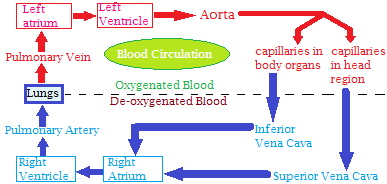Structure of Heart and Blood Circulation
Structure of Heart
 The heart you see drawn on the Valentine is only a rough representation of the actual structure of the heart. Your heart is actually shaped more like an upside-down pear. There are four chambers in heart. These are the right atrium, right ventricle, left atrium and left ventricle.
The heart you see drawn on the Valentine is only a rough representation of the actual structure of the heart. Your heart is actually shaped more like an upside-down pear. There are four chambers in heart. These are the right atrium, right ventricle, left atrium and left ventricle.
There are four valves in the heart which prevent blood from flowing backwards. The positions of the heart valves are:
- between the right atrium and ventricle
- between the left atrium an dventricle
- at the entrance to the pulmonary artery
- at the entrance to the aorta
The muscular wall of the left ventricle is much thicker than the right because it has to pump blood around the whole body. The right ventricle is thinner because it only has to pump blood through the lungs. The heart has its own blood supply from the coronary arteries.
Arteries, veins and capillaries
There are three main types of blood vessels:
Arteries
It takes blood away from the heart to the body organs and tissues. The artery wall is thick and muscular so it can withstand the high pressure of the blood being pumped directly from the heart
Capillaries
These are tiny, thin-walled vessels which form a network to take blood through the organsand tissues
Veins
Veins collect blood from the capillaries in the body and return the blood to the heart. The wall of the veins are thin, the blood is at a much lower pressure. To prevent the backflow of this lower pressure blood the veins contain valves.
Blood Circulation
Blood is circulated around the body through blood vessels by the pumping action of the heart.

In humans, blood is pumped from the strong left ventricle of the heart through arteries to peripheral tissues and returns to the right atrium of the heart through veins. It then enters the right ventricle and is pumped through the pulmonary artery to the lungs and returns to the left atrium through the pulmonary veins. Blood then enters the left ventricle to be circulated again. Arterial blood carries oxygen from inhaled air to all of the cells of the body, and venous blood carries carbon dioxide, a waste product of metabolism by cells, to the lungs to be exhaled. However, one exception includes pulmonary arteries, which contain the most deoxygenated blood in the body, while the pulmonary veins contain oxygenated blood.




